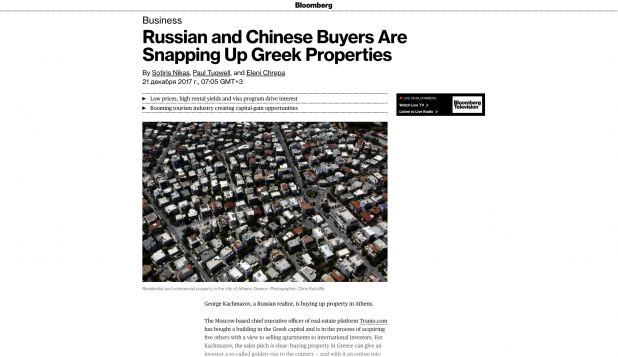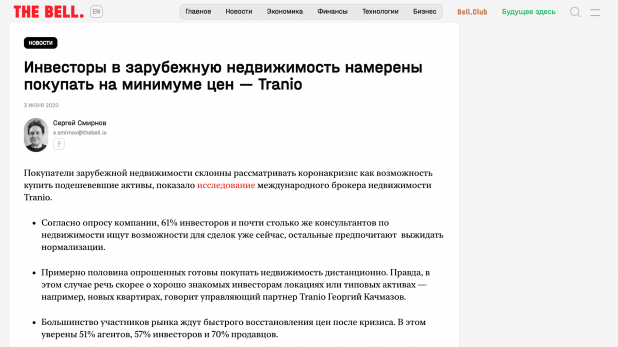My name is Mikhail Bulanov, and I am the Executive Director of international real estate brokerage Tranio. Over the past three years, we have placed links in upwards of a thousand publications in the international mass media — all without spending a dime.
In this article, I will share our experience with promoting the Russian and English versions of our website in the media with no budget.
Don’t fear the media giants
The biggest mistake you can make is to assume that it is impossible to get a major media organization to mention you, and thus make no attempts to reach out to them. Journalists are always on the lookout for good stories, and many of them will appreciate your help in that regard. If you can come up with an interesting idea for a publication that people will read, even the biggest media outlets will grant you a link in return. The key is to develop a good story idea with a solid news peg.
We have placed links and received mentions from The Guardian, Bloomberg, Business Insider, Die Welt, The Times and other major media organizations. The Guardian, for example, published 11 links to our English website in a story featuring some of our more unique properties.

How to come up with a newsworthy topic
As a general rule, we like to generate story topics that include a solid mix of data-driven analysis and hype.
To grab your readers’ attention, don’t just follow the old adage of writing what you know; rather, you should look for topics that surpass the breadth of your business. At Tranio, our niche is overseas property — which is quite narrow, and thus attracts only a small audience; all you have to do is write “mezzanine loan” and you have already scared away all the readers. It is better to focus on more enduring, universal topics: issues involving the rich versus the poor, gender-related issues, regional issues, etc. As an example, lifestyle publications are often happy to pick up such topics as the difference in consumption habits between different demographics, where billionaires are currently snapping up new properties, what countries wealthy Moroccans would like to move to, etc.
A seemingly timeless lifestyle topic we’ve covered was about locations where you can buy a beachfront villa for the same amount as a one-bedroom flat in London. That hasn’t only been incredibly popular when we’ve covered it: whenever analysts produce new findings about that evergreen topic, their work seems to be splashed across multiple media outlets. People are always interested in such topics, because they are always agonising over the fact that property prices in their areas are trending upwards, and looking at beautiful properties abroad offers a leisurely escape.
You can always work up an information agenda and link it to your activities. When the COVID pandemic broke out and markets crashed, we conducted a survey about the market’s future prospects. We considered whether property buyers would prove more likely to invest remotely, or and how these and other factors might impact prices. This article received a wealth of interest, and was exclusively picked up by The Bell.

Once you come up with a research topic such as this that proves popular among readers, you can use the same questions and update your findings every year. Media outlets are often eager to track trends over time, particularly with respect to topics that have proven popular among their readers in the past.
The eternal struggle to find the best data
Big data and big research are increasingly hot topics. And while you might assume these things are better left to the giants like Google and Deloitte, I’m pleased to reassure you that — at perhaps a scaled down level — big research is within your reach.
Of course a small business won’t have the same research bandwidth as Google, but most businesses are capable of compiling data that will be interesting and reflective of the reality on the ground.
Just about every business has some sort of CRM system, which can prove invaluable as a data source. These systems tend to provide a wealth of information, from socio-demographic characteristics, to trends in application sectors, to insights on what people wanted yesterday as compared to what they want today.
Especially for smaller companies, sanity checks are essential once you’ve gathered your initial batch of data. For a variety of reasons, the data you gather may not reflect the full picture. This is where your professional network will prove invaluable.
Reach out to trusted colleagues who also work in your industry and check if they’ve observed similar results in their work. And always check your findings against additional sources. If doing so leads you to feel that your results are questionable, it is better to seek new information.

In addition to CRM, many businesses like to turn to data giants like Google and Yandex, which can be tremendous resources for purposes such as counting and comparing search queries. As an example, in October 2020, we relied on Yandex search query calculations to gauge relocation trends among Russians. Our findings were immediately picked up by the two major Russian media agencies: Interfax and TASS, and then republished by about 50 other media outlets, including Spanish, Latvian and Bulgarian media outlets.
Editorial and PR teams should work in tandem
At Tranio, a key to our marketing success has been employing well qualified PR specialists and editors.
The two groups have a symbiotic relationship, where the PR specialists assess market needs, and then the editorial team produces content that can be shopped out to media organizations. We have found that there is a stronger appetite for ideas paired with well written content, produced by experienced writers and editors, than for ideas alone.
We have come to the conclusion that the most profitable approach to generating links and mentions is to approach the task from two angles: first, a PR manager should pitch an idea to a range of appropriate media outlets. Then, after once a relevant agreement has been reached, the editorial team should prepare the agreed upon material. The editorial team and PR need to be constantly in sync; this makes the whole process go smoothly in our experience.
Other issues to take into account include personality and team dynamics. We have found it critical to have someone with an energetic personality on our staff to oversee the PR and editorial processes. If done well, research and writing are rarely quick, and often entail phased approaches. It is critical to have someone on hand to oversee the process from start to finish.
It is also very important that the production and distribution of research happen in conjunction between the PR and editorial teams. In particular, it’s useful for editors and PR specialists to communicate regularly. Without consistent communication, you risk creating a disjointed situation where an editor produces content that a PR manager can’t convince anyone to publish. This can be easily avoided by ensuring a PR manager has vetted topics before the content is prepared.
Summary
- Most journalists appreciate a good story topic — even those that work for major international media outlets.
- The material you pitch must be unique and of interest to the audience of the particular media outlet you’re reaching out to.
- Expand your topic range: write about what a broader audience will be interested in.
- Don’t be afraid to write about things that have already been written about in the past. Topics like ‘7 mistakes people make when…’ and ‘Where to go on a honeymoon in 2021…’ are evergreen.
- Seek out newsworthy stories and comments promptly on events in your field: speed is pivotal for journalists.
- Do your own research and compare it with that conducted by others.
- Use data from your own sales systems: these systems are ripe with newsworthy topics waiting to be found.
- Sell the idea to the media first, and only then write the text. Otherwise the article might never be published.
I hope my experience will be of use. Now that you know everything you need to know, go forth and spread your links!





